Lelia N. Hawkins

Professor of Chemistry and Hixon Professor of Climate Studies
B.S., University of California, San Diego
PhD, Scripps Institution of Oceanography
Air pollution (especially particulate matter and ozone) contributes to between 6 and 9 million deaths worldwide, annually, and these numbers are likely an underestimate. In 2019, 99% of the world’s population was living in places where the WHO air quality guidelines levels were not met – and the overwhelming majority of these deaths are in low- and middle-income countries. Children, the elderly, and those with respiratory or pulmonary disease are particularly at risk.
Air pollution and climate change are inextricably linked – the same fossil fuels which drive dangerous planetary warming are the leading cause of outdoor air pollution. PM and ozone interact with our climate system through their ability to absorb and reflect sunlight and infrared radiation. And, our warming planet exacerbates both PM and ozone formation through temperature-controlled processes.
There has never been a more important time to study these linked phenomena. Students at Harvey Mudd College are well-positioned to contribute to the body of knowledge informing policy on these issues. Specifically, research in my lab aims to address the general questions, “What are the sources of PM?” and “How are air pollution and anthropogenic climate change interacting?”
To address these questions, students work in one of four major areas:
- ambient measurement of air pollution in real time at HMC and in Joshua Tree National Park
- simulation of light absorbing air pollution (i.e. brown and black carbon compounds) and their atmospheric changes
- mapping local particulate matter with low-cost sensors, and
- development of low-cost soot pollution sensors
This work combines traditional analytical techniques with highly specialized equipment and statistical analyses to understand air pollution better.